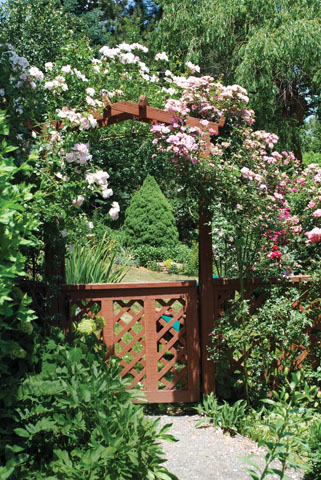Coping with Climate Change
02 Mar 2011
Gardeners know Colorado’s weather wreaks havoc on plants, and it’s not getting any better with global warming. But the way you garden can make a difference in slowing carbon emissions.
Here are sustainable gardening tips from a community gardener.
Text and plant photos by David Wann Gardening in the Front Range is never a cakewalk. And it’s not likely to get any better. 2010 was the planet’s warmest year on record, and each zone in Colorado—plains, foothills and mountains—has moved up a notch on revised USDA hardiness maps. (Find your zone by typing in your zip code at arborday.org/treeinfo/zonelookup.cfm. You can also find tree and shrub suggestions.)“Ours is the wildest weather on the planet,” says Boulder landscaper Jim Knopf. “Arctic fronts collide with tropical air masses here, creating an ever-changing house of horrors.” The Front Range is heating up, and we should prepare for even more bizarre temperature swings, with longer drought cycles, gustier winds and more frequent hail (Ouch!). We growers need to sharpen not only our tools, but also our skills and knowledge. The good news is that many adaptive gardening techniques can actually help prevent the worst effects of climate change.
- Pine needles make great mulch because they don’t blow away and they also add a little acidity to our alkaline soils. Just leave them in place and let seedlings grow through them.

- Dutch clover works great as an off-season cover crop that adds nitrogen to the soil while subtracting CO2 from the air. Turn it under after a healthy mass of growth has done its work, and before the crop reseeds

- Easily constructed hoop-houses made with durable PVC pipe are covered with shade cloth in the summer and plastic in spring and fall.
Hot Ideas
My favorite mulch, especially for acid-loving crops like potatoes, is pine needles. I collect needles from schoolyards and parks in late fall. (The trick is to catch the grounds crew in the act of raking.) During our windy winters, other mulches like leaves, straw and wood chips blow into the next county, but pine needles stay put.When a dry spell drags on and on, stockpiles of mulch keep vegetables and landscapes happy. Once-living materials like compost, leaves, spoiled hay, grass clippings and pine needles keep moisture in the root zone, control weeds that would otherwise steal water from the crop, and moderate soil temperatures.
- Durable cedar boxes covered with chicken wire protect strawberries (that most furry and feathery critters crave) and keep berries a bit cooler.

- Bean trellises, like this one at Boulder’s Growing Gardens, keep roots cool, provide good air circulation, and work well with two rows of drip irrigation pipe.
Be a Drip!
A reliable moisture meter is a good tool to have, as well as a constantly expanding understanding of how much water crops actually need. Tomatoes, for example, are not as thirsty as we think they should be, while beans are especially thirsty, particularly when the pods are developing. Bean leaves turn light green to grayish when they’re really dry, and squash leaves wilt dramatically on hot afternoons, even if they have plenty of water.
- Extend the growing season with cold frames of any type. Even a little bit of shelter helps cool-weather crops thrive before summer heat and fall freezes hit.
Cool Structures
Most vegetable crops need extra water when they’re establishing roots, flowering and developing their final products. Otherwise, deep watering one day and drying-down the next is a good rule of thumb. In cooler months, cold frames and hoop-houses that can be covered with plastic are useful garden structures. Shade cloth is great when temperatures soar. All help to finesse changing weather conditions. A chicken-wire hoop frame and a closable tempered-glass cold frame provide emergency hail protection, too. Homemade circular hoops made with mammal-proof fencing like PVC piping are great for growing tomatoes, cucumbers, peppers and other broad-leafed crops. The hoops also enable a frantic grower to throw old sheets and blankets over plants at the first sign of hail. On days when hail is a possibility, better to be safe than sorry—throw shade cloth or sheets over the hoops when you leave home.Planetary Landscaping
The way we landscape our yards also plays a major role in how much energy our houses use. By planting the right trees, shrubs, vines and grasses in the right places, we can keep our houses cool in summer and warm in winter, by design. This can reduce winter heating bills by as much as 25 percent and summer cooling bills by up to 50 percent, which also reduces energy-related greenhouse gas emissions. The most effective way to keep a home cool is to prevent heat buildup in the first place, so keeping hard surfaces cool is important. Trees and vines create cool microclimates around walls, pavements and other hard surfaces that reduce ambient temperatures dramatically. Planting shrubs, bushes and vines next to your house creates dead air spaces that insulate your home in winter and summer. Leave at least a foot of space between full-grown plants and your home’s wall. Colorado State University Extension agent Steve Cramer suggests Rocky Mountain juniper and eastern red cedar as sturdy, durable evergreens for yard-warming windbreaks. His favorite low-maintenance shade tree is hackberry. “It’s a medium-speed grower, so it doesn’t get brittle, breakable branches. That’s a great quality for a tree planted near your house,” he says. Cramer also recommends Virginia creeper as a dependable trellis-climbing vine to enhance energy conservation (it also turns a brilliant fall red). Other good bets for shady areas are wintercreeper (also a trellis climber) and English ivy, a gripper. For sunny locations, Cramer’s favorite is the clematis vine with brilliantly colored flowers.














